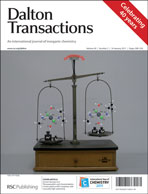Two series of novel boron difluoride adducts (BDFs), namely [BF2(OOR(n))] (type I) and [BF2(OO2R(n))] (type II) (R = C6H4OCnH2n+1; n = 10–18), containing β-diketonate ligands bearing 4-alkoxyphenyl substituents in position 1 or in positions 1,3 of the β-diketonate core, respectively, have been prepared. All of them display a strong interaction between the ligand and the BF2 group, as deduced from the IR spectroscopic data, and strong blue-violet emission (λmaxem from 400 to 440 nm), with fluorescence quantum yields from 0.69 to 0.84 (type I) and 0.48 to 0.66 (type II) and fluorescence lifetimes of 1.7 and 2.2 ns in diluted dichloromethane solution, respectively. The photophysical properties of I and II series of dyes are independent of the solvent polarity and the chain length of the alkoxyphenyl substituent(s). Moreover, they exhibit high photostability even under intense laser light. Contradicting previous interpretations, our detailed photophysical and spectroscopic study rules out excimer formation even in highly concentrated solution or in the solid state, demonstrating the resistance of these dyes to self-aggregation. All those features pave the way to the application of such fluorophores in OLEDs, solid dye lasers, chemical sensors and two-photon biological labels, to name a few.

You have access to this article
 Please wait while we load your content...
Something went wrong. Try again?
Please wait while we load your content...
Something went wrong. Try again?


 Please wait while we load your content...
Please wait while we load your content...